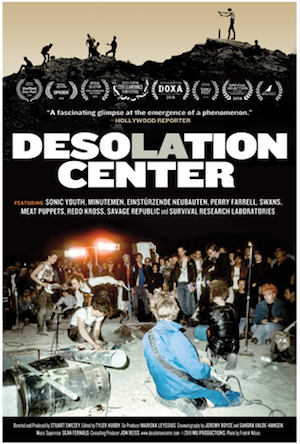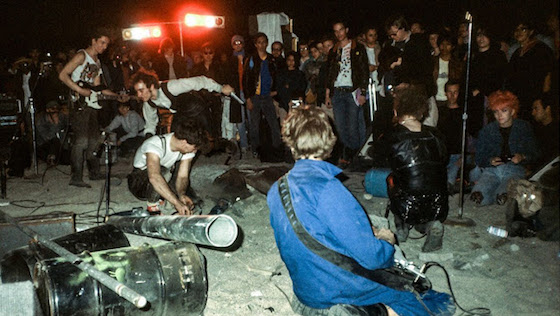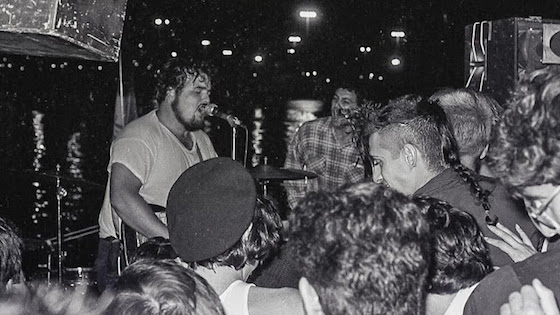

[Rating: Minor Rock Fist Up]
Something of a musical micro-movement hagiography, Desolation Center offers up an engaging history of a very particular scene during a decidedly special time and place, yet one can’t help but to feel that half of the story is missing. Tracing the seeds of a small artistic groundswell that would eventually blossom into a multi-billion-dollar industry, the documentary does an excellent job connecting the dots of this early-80s west coast American punk movement and ethos to what it would become. And while the aftermath is indeed touched on, the unbalanced focus on the triumphs versus the consequences gives the film a lopsided feel: like a story that details the first flight by the Wright brothers without any real discussion of jets, airports, or crashes.
Talking head interviews and archival footage form the basis of Desolation Center, which opens with a brief history of the Los Angeles punk scene of the early-80s, and the trouble fans and bands alike had with the city and the L.A.P.D. The aggressive music and punk-uniformed participants inspired a swift response from the local authorities, who disrupted or otherwise disbanded any show that landed on their radar. Local L.A. promotor, Stuart Swezey (also writer/producer/director of this doc) hit upon an idea to host a multi-act show well outside of the city limits, where the “freaks” could enjoy themselves without any fear of interference.

Keeping with the punk ethic of the movement, Swezey didn’t bother with permitting (or any in-depth planning, really), and sold a hundred or so tickets to a concert in the middle of the California desert. The response from the local punk community was enthusiastic and drew the attention of other performers intrigued by the freedom of such a maneuver, and over the next 3 years or so, a handful of other shows were staged in this DIY fashion. No one got hurt or ripped off, the prices were reasonable, the music was fantastic, and for once, this little community found a place for their unique brand of artistic expression.
Desolation Center makes great use of interviews from participants on both sides of the stage, with local fans of the time and members of the bands all getting time to reflect on their experience with the brief musical experiment. Members of the acts that performed, such as Red Kross, The Minutemen, Sonic Youth, The Meat Puppets, and even Einstürzende Neubauten
are all featured, along with burgeoning artists/attendees like Perry Farrell, all of whom paint a very interesting picture. These people didn’t invent or break ground on the concept of destination concerts, but they did set in motion a movement that would eventually transform into a staple of the music industry.

Yet this is where Swezey’s documentary pulls up short, for it spends a solid 85 of its 90 minutes detailing the growth and evolution of this small-scale experiment, and the wild stories involved in each (including one event where everyone got dosed with LSD) without any serious exploration of the long-term consequences. This doesn’t make Desolation Center a bad documentary, but it does tease at the seeds of a cinematic exploration that is absent, here. The fact that these desert shows presaged a global musical movement that has become everything these small concerts opposed is an irony that is briefly presented in the last five minutes, but it is never really explored.
The punk movement was born out of a defiant call to arms for all the cast off, unfashionable, poor, and anti-social elements of society, and these desert shows were the natural extension of their quest to find a place where they could revel, unburdened, in their “otherness.” Swezey does a fantastic job stitching the history of this organic movement together as a reflection of this, yet pulls back when approaching what can only be seen as an indictment of what this idea has become. Like some kind of mohawk’d Frankenstein: Coachella, Burning Man, and even Lollapalooza have grown beyond their master’s intentions and more or less murdered them. Influencer culture and $1000 tickets have obliterated any semblance of connective tissue between these first desert shows, designed as safe havens for the dregs of L.A. society, and their arguably grotesque modern incarnations.
It really does feel like a missing piece of a larger puzzle, and something that would have brought not only context, but also a deeper appreciation for what Swezey and his tribe of punk heroes accomplished during those handful of years 30+ years ago. Desolation Center is a celebration of their vision, and rightly so, but it would have been so very interesting to explore the ways the movement’s predecessors corrupted the original concept. Opening today in limited release, the documentary is a must-see for fans of the early-80s punk scene, and an interesting peek into a movement that has spawned a colossal industry. Had Swezey dug a bit deeper and attempted a critical analysis rather than just a celebration of his creation, it might have been so much more, however. But hey, that’s punk, right? As Mr. Johnny Rotten once said, “Don’t ask us to attend ‘cos we’re not all there/Oh don’t pretend ‘cos I don’t care.”





Comments on this entry are closed.